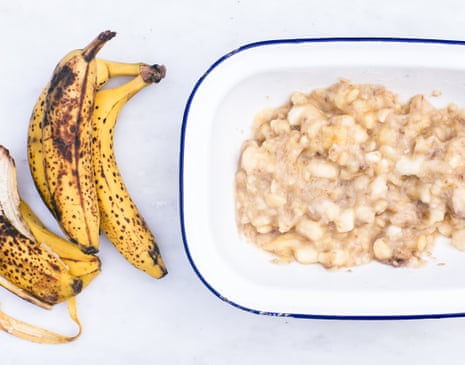Squashing brown bananas in your hands is surprisingly sensual: it oozes out between your fingers into a squidgy mess that can then be massaged into your feet as a surprisingly effective, if rather odd, deodorising foot moisturiser. Alternatively, freeze it, then blend into an instant “ice-cream” or ferment it into a vinegar.
Banana vinegar is aromatic, rich and has a funky, sweet and acidic flavour that’s ideal in a tropical-flavoured vinaigrette dressing, cordial, ceviche or simply to use in place of regular vinegar.
The peel also has several uses. Cook organic banana skins (ie, ones that are free from synthetic pesticides and fungicides) with spices to make Conor Spacey’s spicy banana peel chutney or whizz them up to make my take on katsu curry sauce. The insides of non-organic skins, meanwhile, can be used as skin cleanser or garden fertiliser.
Banana vinegar
This funky and delicious vinegar is made very simply by leaving bananas to ferment in the sun. Because of the sugars in bananas, the vinegar-making process from fruit to ethanol to acetic acid is very quick here, turning it into vinegar in just a few weeks. Brown or even blackened bananas are best for making vinegar, because they are very sweet and have already started to ferment. Even one banana will make a few portions of vinegar with very little work. Try making a small batch and leave it on a windowsill, or save up brown bananas in the freezer until you have as many as you need.
Makes 1 jar
Brown bananas, peeled
after newsletter promotion
Peel the bananas and put the flesh in a bowl. With clean hands, mash the fruit between your fingers, then pack into a sterilised jar. Cover with a clean tea towel or piece of cheesecloth and secure in place with a piece of string or elastic band. Ferments should usually be kept out of direct sunlight, but banana vinegar benefits from the light, which helps the fruit to break down. Stir the mixture once and, ideally, twice a day to prevent mould forming on the surface. After two weeks, the bananas should have liquefied and turned acidic; simply taste to test when the mixture is vinegar-like enough for your liking. At this point, strain the mix through a sieve or keep it as a more viscous vinegar solution with the banana mash still in it, then transfer to a clean jar, seal and store in the fridge for up to a month, stirring it once a week to prevent mould forming.

Comments (…)
Sign in or create your Guardian account to join the discussion